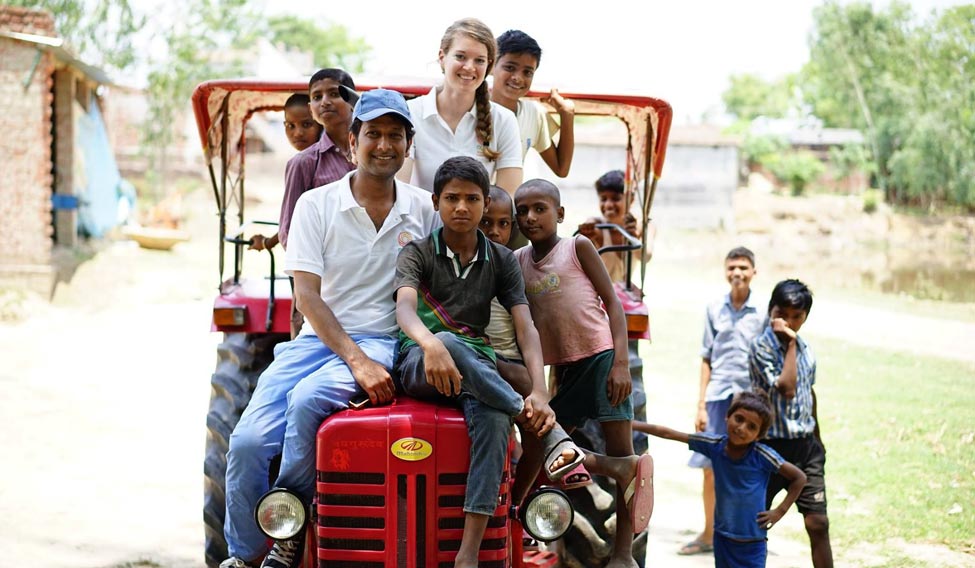Almost 70 years after attaining independence from the British, a small village in India finally managed to experience electricity for the first time, thanks to a British student.
Clementine Chambon, a PhD student from the prestigious Imperial College, London, has helped connect homes in Sarvantara, a village in Bahraich district of Uttar Pradesh, with a mini eight-KWh solar energy grid via her social enterprise startup company—Oorja—last month.
Clementine co-founded this for-profit social enterprise along with Amit Saraogi with an aim to provide clean energy access to off-grid communities in rural India.
Ask her what motivated them to come up with a social enterprise and Clementine, CTO, Oorja, says, “Our respective life experiences, the resulting sensitivity to concerns of community development, and the desire to leverage our education and experiences in a meaningful pursuit professionally resulted in Oorja. Amit grew up alongside a big population living in extreme poverty without access to basic services. I equally witnessed extensive social exclusion during my travels in rural China, ingraining in me a strong sense of socially aware citizenry. It is unacceptable to us that despite rapid economic growth, majority of the population subsists on less than $2 a day, enduring serious deprivations.”
Talking about the India opportunity, she avers, “Rural India is a place of both widespread poverty and agri-waste abundance and governments alone cannot provide all the solutions. This compels us to apply our expertise to empower local communities to live with dignity.”
Prod her on the choice of this particular village and she says, “We conducted extensive site selection and energy demand surveys, which enabled us to analyse energy demand, affordability and ability to pay among these consumers. We also established a good relationship with local panchayat members and leveraged Amit’s family network in Bahraich, which made it a good spot for our first project.”
But from managing suppliers to procuring equipment from vendors spread across India and abroad, it just wasn’t easy to make it happen in Sarvanatara. Add to it the usual socio-cultural barriers and caste dynamics prevalent in rural India and it becomes all the more complex.
“We worked closely with local communities and other stake holders to eventually make this possible,” tells Clementine, before adding, “And we learnt a lot as well from this experience, which happens to be our first.”
But Oorja customers like Munnu Lal and others from Sarvantara village have no idea of what all went into the installation of this mini grid that changed their lives forever. They are obviously too happy to think over it.
“Thanks to Clementine madam, our village managed to experience electricity for the first time ever,” says a grateful Munnu Lal, who also happens to be a former pradhan of this village.
Munnu adds, “Though we attained independence almost seven decades ago, we experienced electricity in our homes only now. It was like a festival for us. As soon as the village folk got to know that soon they’ll have access to electricity, everyone wanted to buy refrigerators, TV sets, and washing machines. Sadly the current facility would not be able to support that type of a demand. But we are anyway happy with what we are getting. Something is better than nothing.”
The basic tariff of this supply is Rs 130 per month (4W bulb, mobile phone charging) and it increases up to Rs 360 per month (4W bulb, 1W bulb, mobile phone charging and fan). Earlier, villagers were spending Rs 200 on a month’s consumption of kerosene for illumination and Rs 50 per month on the head of mobile phone charging.
"Oorja even powers irrigation pumps and very competitive rates," says Clementine.
Team Oorja plans to raise funds to finance its expansion plan of building 20 mini-grids by the next year. Then, Oorja plans to install hybrid biomass/solar mini-grids that will use agricultural waste and solar cells to provide reliable power to businesses.
“We will help develop these SMEs through entrepreneurial education programs (access to finance, financial literacy and capacity building). We will begin to franchise these power stations in 2018 to scale up faster and aim to reach 1 million underserved people by 2022,” explains Clementine.
Talking about the business model and profitability, Amit Saraogi, CEO, Oorja, tells, “Generally the break even in this sector is about 7 years, depending on the size and scale. However, given our business model, we aim to be operationally profitable in three to four years.”
Amit’s confidence probably finds roots in the energy demand-supply gap, which the government has sadly not been able to bridge. However, considering the volume of this demand, such micro enterprises may not be able to absolutely bridge the mammoth supply gap but they definitely are a welcome step.
So is Oorja business model scalable? “Yes,” says Amit. He explains further, “Ours is a unique micro-franchise business model that leverages existing networks and trust of local communities in rural UP and that allows us to scale rapidly. We build, install, commission, and maintain AC hybrid (biomass and solar) mini-grids to serve energy needs of small businesses (like rice mills, cold storages, dairy chilling, banks, schools, etc.) and DC solar micro-grids to serve household lighting needs and irrigation pumps. These grids are owned / leased-to-own and operated by a local micro-entrepreneur or women' self help group. This frees our time from actual day to day operations to develop more projects and also reduces our payback time.”
Now that’s quite an em'power'ing business model.






